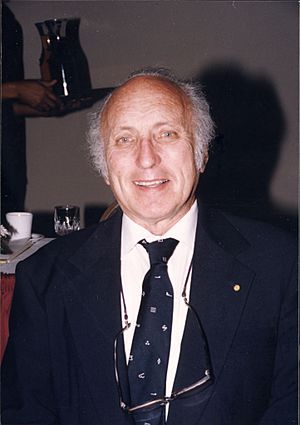Edwin Kessler facts for kids
Quick facts for kids
Edwin Kessler III
|
|
|---|---|
 |
|
| Born | December 2, 1928 |
| Died | February 21, 2017 (aged 88) Cedar Park, Texas, US
|
| Education | Columbia University (1950) MIT (M.S., 1952; Sc.D., 1957) |
| Known for | Overseeing development of Doppler weather radar, Kessler Microphysics Scheme, first director of National Severe Storms Laboratory |
| Awards | Cleveland Abbe Award |
| Scientific career | |
| Fields | Meteorology |
| Institutions | Cambridge Research Laboratories, Travelers Research Center, NSSL |
| Theses |
|
| Doctoral advisor | Henry G. Houghton |
| Other academic advisors | J. M. Austin |
| Influences | David Atlas, Edward Norton Lorenz |
| Influenced | Edward Norton Lorenz, Howard Bluestein |
Edwin Kessler III (born December 2, 1928 – died February 21, 2017) was an American atmospheric scientist. He helped develop Doppler weather radar. He was also the first director of the National Severe Storms Laboratory (NSSL).
Contents
Early Life and Education
Edwin Kessler was born in Brooklyn, New York, on December 2, 1928. He was the oldest of three sons. During his father's military service, Edwin and his family lived in Corpus Christi, Texas.
He finished Corpus Christi High School in 1946. He then joined the Army for 18 months. After serving, he returned to Columbia University and graduated in 1950.
In 1950, Kessler married his high school classmate, Lottie Catherine Menger.
Career in Meteorology
After college, Kessler joined the Air Force. He moved to Massachusetts and earned two advanced degrees from MIT. He also studied astronomy at Harvard.
He became a captain in the Air Force Reserve. There, he worked with weather radar. In 1960, he worked at the Travelers Research Center in Connecticut.
Leading the National Severe Storms Lab
In 1964, Kessler became the first director of the National Severe Storms Laboratory (NSSL). This lab is in Norman. He worked there as a researcher and a manager until he retired in 1987. He was also a professor at the University of Oklahoma.
Developing Doppler Radar
Under Kessler's leadership, NSSL got a Doppler radar unit in 1969. It started working in 1971. Kessler believed this technology would be a big improvement over older radar systems.
He supported programs where scientists would chase storms to study them. In 1973, the experimental Doppler radar recorded the entire life cycle of the Union City, Oklahoma, tornado. This was a major success for storm research.
Studies from this event led to new ideas about storms. The success of collecting data in the field made storm chasing an important part of severe storm research. NSSL's radar work also helped create NEXRAD, which is a network of advanced weather radars used today.
Kessler Microphysics Scheme
Edwin Kessler also created the Kessler Microphysics Scheme. This is a way to understand how tiny water droplets and ice crystals form clouds and precipitation. Scientists still use this scheme in atmospheric modeling and numerical weather prediction (NWP). NWP uses computers to predict the weather.
Kessler advised groups like the National Center for Atmospheric Research (NCAR) and NASA. He also helped organizations in other countries. Many people credit Kessler for bringing together government, universities, and private companies. This made Norman, Oklahoma, a major center for weather research and forecasting.
Publications and Awards
Kessler wrote or co-wrote over 250 scientific papers. He also published many reports and books. His research focused on radar meteorology, aviation weather, and how precipitation forms.
He was a member of several important scientific groups, including the American Meteorological Society (AMS). He received the AMS Cleveland Abbe Award for his "distinguished service" in studying severe storms and radar meteorology. After retiring, he continued to work as a consultant, especially for investigations of aviation accidents and incidents.
After Retirement
After retiring, Kessler stayed very interested in politics. He cared about protecting the environment and making government more open. He supported wind power and other alternative energy sources. He also promoted sustainable transport and sustainable agriculture.
He managed a 350-acre farm near Purcell, Oklahoma. This farm had cattle and was an organic farm. In the 1980s, he started giving parts of the farm to the University of Oklahoma. This land became the Kessler Atmospheric and Ecological Field Station (KAEFS).
Kessler Atmospheric and Ecological Field Station
The KAEFS is a research site that shows how to care for the environment. It includes efforts to restore prairie lands. Scientists also observe climate, weather, and space weather there. The station has a mesonet weather station and other tools to collect data.
Kessler became more vocal about politics after he retired. He worked with an organization called Common Cause. He helped monitor the actions of government groups to ensure transparency. He also joined other scientists in opposing a funding plan for the National Weather Center building.
Family and Legacy
Edwin Kessler's wife, Lottie, passed away in 2011. He died on February 21, 2017, at the age of 88, in Cedar Park, Texas. He was with his son, Austin. He is also survived by another son, Thomas. His ashes were buried at the Kessler Atmospheric and Ecological Field Station.
See also
- Donald W. Burgess
- Leslie R. Lemon
- Roger Lhermitte

